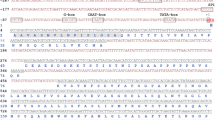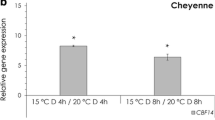Abstract
Two cDNAs coding for putative light-stress proteins of barley (Hordeum vulgare L.) were cloned and the expression of the corresponding mRNAs analyzed in the barley leaf and compared to that of the well-studied ELIP (early light-inducible protein) mRNA. During greening the mRNA for clone HL # 2, which shows homology to two rice proteins of as yet unknown function, was transiently induced; its level rose more slowly and remained elevated for a longer time than was described for ELIP mRNAs. The mRNA corresponding to clone HL # 13 was recognized as homologous to subunit P of pea glycine decarboxylase, a nuclear-encoded mitochondrial protein involved in photorespiration. Its mRNA level rose more slowly with cellular development than that of the mRNA for LHC II, the apoprotein of the chlorophyll-a/b-binding protein of PSII. The mRNAs of both novel proteins were induced by high light up to an irradiance of 2000 W·m−2. Their levels remained elevated under high light for up to 9 h, the longest time span examined, while after return to culture light conditions the mRNAs rapidly decayed, each with an individual time course. In green barley leaves the mRNA for clone HL # 2 was expressed to the highest level in the most basal segment, similar to that of ELIPs, while in contrast the mRNA for subunit P of glycine decarboxylase accumulated to the highest level in the leaf apex where the fully developed cells and mitochondria reside. The latter finding strongly indicates that photorespiration is regulated by high light also at the level of mRNA transcription or mRNA accumulation. In addition, we show that perception of light stress is under the control of cellular development and differentiation.
Similar content being viewed by others
Abbreviations
- ABA:
-
abscisic acid
- ELIP:
-
early light-inducible protein
- GDC:
-
glycine decarboxylase
- HL:
-
high light (2000 W·m−2)
- LHC II:
-
apoprotein of chlorophyll-a/b-binding protein of PSII
- LL:
-
low light (20 W·m−2)
- P-GDC:
-
P-subunit of GDC
References
Adams WW, Demmig-Adams B (1992) Operation of the xanthophyll cycle in higher plants in response to diurnal changes in incident sunlight. Planta 186: 390–398
Adamska I, Kloppstech K, Ohad I (1992) UV-light stress induces the synthesis of the early light inducible protein and prevents its degradation. J Biol Chem 267: 24732–24737
Adamska I, Ohad I, Kloppstech K (1993) The early light-inducible protein (ELIP) in pea is stable during light stress but is degraded during recovery at low light intensity. J Biol Chem 268: 5438–5444
Apel K, Kloppstech K (1978) The plastid membranes of barley (Hordeum vulgare). Light induced appearance of mRNA coding for the apoprotein of the light-harvesting chlorophyll a/b protein. Eur J Biochem 85: 581–588
Aro E-M, Virgin I, Andersson B (1992) Photoinhibition of photo-system II. Inactivation, protein damage and turnover. Biochim Biophys Acta 1143: 113–134
Barkadottir RB, Jensen BF, Kreiberg JD, Nielsen PS, Gausing K (1987) Expression of selected nuclear genes during leaf development in barley. Dev Genet 8: 495–511
Bartels D, Hanke C, Schneider K, Michel D, Salamini F (1992) A desiccation-related ELIP-like gene from the resurrection plant Craterostigma plantagineum is regulated by light and ABA. EMBO J 11: 2771–2778
Beggs CB, Wellmann E (1994) Photocontrol of flavonoid biosynthesis. In: Kendrick RE, Kronenberg GMH (eds) Photomorphogenesis in plants. Kluwer Academic Publishers, Dordrecht, pp 733–751
Claes B, Dekeyser R, Villarroel R, Van der Bulcke M, Bauw G, Van Montagu M, Caplan A (1990) Characterization of a rice gene showing organ specific expression in response to salt stress. Plant Cell 2: 19–27
Debel K, Knack G, Kloppstech K (1994) Accumulation of plastid HSP23 of Chenopodium rubrum is controlled post-translationally by light. Plant J 6: 79–85
de Pater S, Hensgens LAM, Schilperoort RA (1990) Structure and expression of a light-inducible shoot-specific rice gene. Plant Mol Biol 15: 399–406
Greenberg BM, Gaba V, Canaani O, Malkin S, Mattoo AK, Edelman M (1989) Separate photoreceptors mediate degradation of the 32 kDa photosystem II reaction centre proteins in visible and UV light. Proc Natl Acad Sci USA 86: 6617–6620
Grimm B, Kruse E, Kloppstech K (1989) Transiently expressed early light-inducible thylakoid proteins share transmembrane domains with light-harvesting chlorophyll binding proteins. Plant Mol Biol 13: 583–593
Hay B, Short JM (1992) ExAssist helper phage and SOLR cells for Lambda ZAPII Excisions. Strategies 5: 16–18
Kloppstech K (1985) Diurnal and circadian rhythmicity in the expression of light-induced plant nuclear messenger RNAs. Planta 165: 502–506
Levy H, Tal T, Shaish A, Zamir A (1993) Cbr, an algal homolog of plant early light-induced proteins, is a putative zeaxanthin binding protein. J Biol Chem 268: 20892–20896
Lenne C, Douce R (1994) A low molecular mass heat-shock protein is localized to higher plant mitochondria. Plant Physiol 105: 1255–1261
Mullet JE (1988) Chloroplast development and gene expression. Annu Rev Plant Physiol Plant Mol Biol 39: 475–502
Pecker I, Chamovitz D, Linden H, Sandmann G, Hirschberg J (1992) A single polypeptide catalyzing the conversion of phytoene to zeta-carotene is transcriptionally regulated during tomato fruit ripening. Proc Natl Acad Sci USA 89: 4962–4966
Pötter E, Kloppstech K (1993) Expression of early light-inducible proteins in the barley developmental leaf gradient under light stress. Eur J Biochem 214: 779–786
Prasil O, Adir N, Ohad I (1992) Dynamics of photosystem II: Mechanism of photoinhibition and recovery processes. In: Barber J (ed) Topics in photosynthesis 11. Elsevier, Amsterdam, pp 295–348
Sambrook J, Fritsch EF, Maniatis T (1989) Molecular cloning: a laboratory manual. Cold Spring Harbour
Sanger F, Nicklen S, Coulson AR (1977) DNA sequencing with chain-terminating inhibitors. Proc Natl Acad Sci USA 74: 5463–5467
Schweinfest CW, Henderson KW, Gu J-R, Kottaridis SD, Besbeas S, Panotopoulos E, Papas T (1990) Subtraction hybridization cDNA libraries from colon carcinoma and hepatic cancer. Genet Ann Technol Appl 7: 64–70
Short JM, Fernandez JM, Sorge JA, Huse WD (1988) Lambda ZAP: a bacteriophage lambda expression vector with in vivo excision properties. Nucleic Acids Res 16: 7583–7600
Turner SR, Ireland R, Rawsthorne S (1992) Cloning and characterization of the P-subunit of glycine decarboxy lase from pea (Pisum sativum). J Biol Chem 267: 5355–5360
Wu J, Neimanis S, Heber U (1991) Photorespiration is more effective than the Mehler reaction in protecting the photosynthetic apparatus against photoinhibition. Bot Acta 104: 283–291
Author information
Authors and Affiliations
Additional information
This work was generously supported by the Deutsche Forschungs-gemeinschaft, Bonn.
Rights and permissions
About this article
Cite this article
Pötter, E., Beator, J. & Kloppstech, K. The expression of mRNAs for light-stress proteins in barley: Inverse relationship of mRNA levels of individual genes within the leaf gradient. Planta 199, 314–320 (1996). https://doi.org/10.1007/BF00196574
Received:
Accepted:
Issue Date:
DOI: https://doi.org/10.1007/BF00196574




